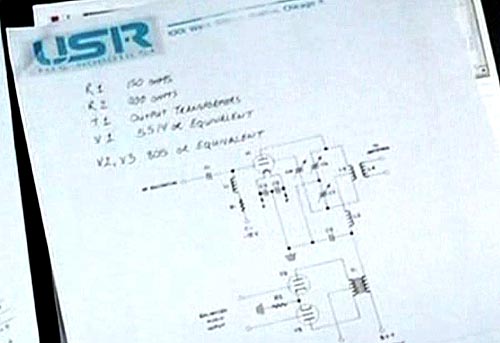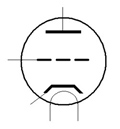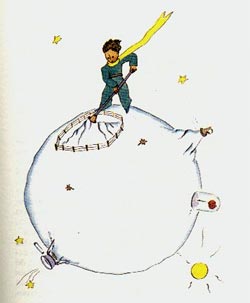The idea of a time traveler messing up the present by changing the past is a Sci-Fi staple, and is used to good advantage in Ray Bradbury’s 1952 short story, “A sound of thunder”. Bradbury’s subtlety is sadly lost in the 2005 movie of the same name; here, silly looking monsters run amok in the perturbed present of the movie. If you haven’t watched it, you may wish to save your time for something better.
However, there is one monster that caught my attention. This is a 50-foot eel-like monster that happily chases the humans in the flooded subway tunnels. here are two shots of its head:

These photos don’t do the eel justice -this is one creature you don’t want to be close to – but what struck my associative imagination at once was the certainty that I’ve seen this face before!
 You can see where I’d met it in the image at right. This is a detail from John Tenniel’s illustration of the Jabberwock, the monster in Lewis Carroll’s immortal nonsense poem from the second Alice book, “Through the looking glass”. Here is the very same bulbous head on a long neck, with the four tentacles and the bulging eyes. Only the dentition is different.
You can see where I’d met it in the image at right. This is a detail from John Tenniel’s illustration of the Jabberwock, the monster in Lewis Carroll’s immortal nonsense poem from the second Alice book, “Through the looking glass”. Here is the very same bulbous head on a long neck, with the four tentacles and the bulging eyes. Only the dentition is different.
So how did the Jabberwock and the Eel come to be so similar? I see two possibilities. Perhaps the movie’s effects people had seen the Tenniel classic and copied it, consciously or otherwise. But if they haven’t, we may have here a strange case of convergent evolution, where two unrelated creatures evolve in parallel under similar constraints and attain the same outcome. What parallel constraints, you ask? Well, in both cases the artists were striving to objectify nonsense. Carroll’s Jabberwock is part of a wonderful nonsense poem; whereas the movie, though far from wonderful, is itself a sorry piece of cinematic nonsense!
There is a progression in the components of electronic computers. In the forties and fifties they were made of vacuum tubes; in the sixties, of transistors; in the seventies and later of increasingly dense silicon chips. And in the future, according to the vision of SciFi master Isaac Asimov, there will be positronic brains, small enough to fit in a robot’s skull, and they will be based on the interplay of positronic potentials in a platinum-iridium matrix. But wait… according to Hollywood, there will be something else.
Enter the 2004 movie “I, Robot”. This has its drawbacks, from the blatant product placement to the inevitable hyperactive hollywoodization of Asimov’s lovely book. Still, the CG robots are neat, and I enjoyed watching it – and something caught my eye about 66 minutes into the film. At that point, the robotic protagonist Sonny sketches its dream for the benefit of Will Smith, and it shuffles some loose notepaper on the lab workbench. The paper has the US Robotics letterhead, and is filled with scientific-looking schematics and stuff. But as one sheet of paper was uncovered for a second, I instinctively recognized a familiar symbol.

 Here is the capture of that frame, and what I glimpsed are the three circles. They’re fuzzy enough, but to a techie of my generation they’re unmistakable: these are the symbols of triode vacuum tubes. In fact, the parts list above the schematic names some of them as “805 or equivalent”; the 805 was a hefty power amplifier triode, as specified here.
Here is the capture of that frame, and what I glimpsed are the three circles. They’re fuzzy enough, but to a techie of my generation they’re unmistakable: these are the symbols of triode vacuum tubes. In fact, the parts list above the schematic names some of them as “805 or equivalent”; the 805 was a hefty power amplifier triode, as specified here.
So – in 2035 they will have positronic brains of incredible miniaturization, and they will also make use of the clunky glass tubes that were in use during World War II. Right.
Whoever prepared the props for this scene must’ve grabbed the schematics and text from some old technical manual… and it can’t even be a matter of product placement, since these tubes are no longer in serious use. Just sloppiness…
 Apple Computer’s incredibly talented design team has had a major influence on the design of contemporary mobile electronics: just visit a cellular phone store and you’ll see how all the companies are scrambling to copy the iPhone’s sleek look and feel, both the hardware and the software.
Apple Computer’s incredibly talented design team has had a major influence on the design of contemporary mobile electronics: just visit a cellular phone store and you’ll see how all the companies are scrambling to copy the iPhone’s sleek look and feel, both the hardware and the software.
Well, apparently this influence goes beyond mobile devices. Today I was at a home appliance store, and to my amazement I saw the apparition in this photo. It is, clearly, a refrigerator; but its front looks exactly like an iPhone, from the black glass of the doors to the brushed metal band around them.
Apple is certainly not stopping at dominating the cellphone and computer markets. One must wonder what will come next? iPhone-like cars? Or maybe iPad-like Buildings? 🙂
This morning my notebook’s battery died an ignominious death, and I had to hurriedly procure a new one. Not a good start for the day.
I called the vendor’s customer support center, and plodded through the Interactive Voice Response (IVR) menu, fully expecting a harrowing experience. Instead, I was routed to a service rep who gave me the information I needed (well, it was not rocket science after all) but did it in a manner that completely undid the bad mood I was in. It’s hard to put a finger on it, but she was cheerful, confident, friendly, and really conveyed the feeling that she was proud to be able to solve my problem, and solve it fast. Basically this woman was transmitting good service vibes, and the positive mood was contagious.
I suppose it goes to this particular rep’s character and style, but the difference from service reps I usually talk to anywhere was impressive. The others were polite (or not) and doing a job; this one was enjoying it. What a difference this can make in the user experience!
 Here is a screenshot from the form you fill to join the El Al Frequent Flier club. The form has the usual fields (take my word for it, you to whom Hebrew is Greek), but the one that drew my attention is the Title field preceding the first name. This uses a drop-down box, which presents a very comprehensive set of options: there’s Mr and Mrs, There’s Dr, there’s Prof and Rabbi (hey, this is El Al), and there’s even Adv and Judge. But the one highlighted in the screenshot is – get this – Lord.
Here is a screenshot from the form you fill to join the El Al Frequent Flier club. The form has the usual fields (take my word for it, you to whom Hebrew is Greek), but the one that drew my attention is the Title field preceding the first name. This uses a drop-down box, which presents a very comprehensive set of options: there’s Mr and Mrs, There’s Dr, there’s Prof and Rabbi (hey, this is El Al), and there’s even Adv and Judge. But the one highlighted in the screenshot is – get this – Lord.
Which is really amusing… for one, El Al is Israel’s airline and we have no Lords in our system here. Nor do we have a flood of British nobility flying in and out all the time; I’m sure some Lords may fly El Al on occasion, but hardly enough of them to justify such consideration. In any case, if we have Lord, why not Earl, Baron, Marquess, Viscount, or – more useful – a plain generic Sir? And why stop at British noblemen – surely a traveler might be a Graf, or an Alderman, or a Fellow of the Royal Society?
And, while they’re at it, what about Lady?
Edible fruit have been on this planet since the Cretaceous, but they know how to move ahead with the times.
See the photo: this pear, recently arrived from our greengrocer, has a barcode on it!

Why does a pear need its own barcode? I could understand putting one on the crate, for easier shipping control and stock management; but nobody scans an individual pear, do they? In fact, people have been eating pears for ages (seven millennia, more or less), and for 99.9% of that time they managed just fine without a barcode, as you can see in this snippet from a botanical illustration from 1771.


And our modern pear has more than a barcode: it has a logo, and it has a catalog number, and – wonder of wonders – it has a Web site! This is nicely done, chock full of pear lore and fun. I’d joke that at this rate it will soon have its own fruity Facebook account, but of course, it already does. And it’s on Twitter, too: @usapears.
These Generation Y pears sure are getting ahead in our hyper-connected world! 🙂
 I was in a building where someone decided to give the signage a modern look, and I saw this sign outside a restroom. The people have this angular look, with slanted heads – why not? Anything for effect…
I was in a building where someone decided to give the signage a modern look, and I saw this sign outside a restroom. The people have this angular look, with slanted heads – why not? Anything for effect…
But it does occur to me that the guy on the wheelchair with the nonagonal wheel (yep… look it up!) will have a rather bumpy ride. There’s a reason why the inventor of the wheel chose to make it round!
 Check the new article on my History of Computing exhibit: a century old teaching aid from Germany, with the added twist that it anticipates today’s well known slogan: “To each pupil his own counting machine!”
Check the new article on my History of Computing exhibit: a century old teaching aid from Germany, with the added twist that it anticipates today’s well known slogan: “To each pupil his own counting machine!”
I was shopping at Office Depot, and next to the checkout line they had this bin full of cheap items on sale. And in it, thrown carelessly with less decorum than potatoes get at the grocer’s, were blister-packaged Flash memory cards.

They had 2.0 GB units selling for a pittance. That’s two billion bytes, or 16 Billion bits. I remember Thirty years ago, when a solid state memory board of 16K Bytes would come very carefully packaged – rightly so, as it cost thousands of dollars. The unit in the blister pack shown has a Million times as much capacity and costs 10 bucks. Of course we all know how Moore’s law is driving densities up and price per bit down, but this infamy of selling Gigabytes like peanuts brings it home with some poignancy.
And Below is a similar case, this from our neighborhood general store. Here the Flash Disk-on-key packs are hanging from a shelf alongside Energizer batteries, chocolates, candy and chewing gum packages.
You can bet the core memory stack I show here was not sold with chewing gum…

I never dreamed I’d be blogging a post with the word Eyjafjallajökull in its title…
Anyway, this volcano is belching again, and airports are closing again – and one can’t help but wonder at the shoddy maintenance practices of these Icelanders. I mean, it’s not like they don’t know a volcano needs to be properly maintained; it’s well documented in the literature:
 “He carefully cleaned out his active volcanoes. He possessed two active volcanoes; and they were very convenient for heating his breakfast in the morning. He also had one volcano that was extinct. But, as he said, “One never knows!” So he cleaned out the extinct volcano, too. If they are well cleaned out, volcanoes burn slowly and steadily, without any eruptions. Volcanic eruptions are like fires in a chimney.”
“He carefully cleaned out his active volcanoes. He possessed two active volcanoes; and they were very convenient for heating his breakfast in the morning. He also had one volcano that was extinct. But, as he said, “One never knows!” So he cleaned out the extinct volcano, too. If they are well cleaned out, volcanoes burn slowly and steadily, without any eruptions. Volcanic eruptions are like fires in a chimney.”
– The little prince, ch. 9.
From what we hear Iceland uses its geothermal energy extensively, whether or not they use it for heating breakfast… you’d think they could do the preventive maintenance part too!
When will they ever learn?…

 You can see where I’d met it in the image at right. This is a detail from John Tenniel’s illustration of the Jabberwock, the monster in Lewis Carroll’s immortal nonsense poem from the second Alice book, “Through the looking glass”. Here is the very same bulbous head on a long neck, with the four tentacles and the bulging eyes. Only the dentition is different.
You can see where I’d met it in the image at right. This is a detail from John Tenniel’s illustration of the Jabberwock, the monster in Lewis Carroll’s immortal nonsense poem from the second Alice book, “Through the looking glass”. Here is the very same bulbous head on a long neck, with the four tentacles and the bulging eyes. Only the dentition is different.

 Apple Computer’s incredibly talented design team has had a major influence on the design of contemporary mobile electronics: just visit a cellular phone store and you’ll see how all the companies are scrambling to copy the iPhone’s sleek look and feel, both the hardware and the software.
Apple Computer’s incredibly talented design team has had a major influence on the design of contemporary mobile electronics: just visit a cellular phone store and you’ll see how all the companies are scrambling to copy the iPhone’s sleek look and feel, both the hardware and the software. Here is a screenshot from the form you fill to join the El Al Frequent Flier club. The form has the usual fields (take my word for it, you to whom Hebrew is Greek), but the one that drew my attention is the Title field preceding the first name. This uses a drop-down box, which presents a very comprehensive set of options: there’s Mr and Mrs, There’s Dr, there’s Prof and Rabbi (hey, this is El Al), and there’s even Adv and Judge. But the one highlighted in the screenshot is – get this – Lord.
Here is a screenshot from the form you fill to join the El Al Frequent Flier club. The form has the usual fields (take my word for it, you to whom Hebrew is Greek), but the one that drew my attention is the Title field preceding the first name. This uses a drop-down box, which presents a very comprehensive set of options: there’s Mr and Mrs, There’s Dr, there’s Prof and Rabbi (hey, this is El Al), and there’s even Adv and Judge. But the one highlighted in the screenshot is – get this – Lord.


 I was in a building where someone decided to give the signage a modern look, and I saw this sign outside a restroom. The people have this angular look, with slanted heads – why not? Anything for effect…
I was in a building where someone decided to give the signage a modern look, and I saw this sign outside a restroom. The people have this angular look, with slanted heads – why not? Anything for effect… Check the
Check the 

 “He carefully cleaned out his active volcanoes. He possessed two active volcanoes; and they were very convenient for heating his breakfast in the morning. He also had one volcano that was extinct. But, as he said, “One never knows!” So he cleaned out the extinct volcano, too. If they are well cleaned out, volcanoes burn slowly and steadily, without any eruptions. Volcanic eruptions are like fires in a chimney.”
“He carefully cleaned out his active volcanoes. He possessed two active volcanoes; and they were very convenient for heating his breakfast in the morning. He also had one volcano that was extinct. But, as he said, “One never knows!” So he cleaned out the extinct volcano, too. If they are well cleaned out, volcanoes burn slowly and steadily, without any eruptions. Volcanic eruptions are like fires in a chimney.”
